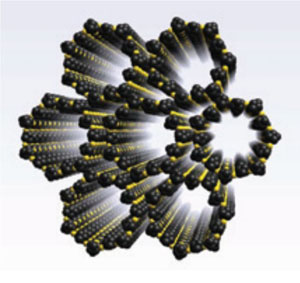US chemists have developed a novel class of materials that are porous and structured like a honeycomb. They have demonstrated that the materials can effectively separate hydrogen from a complex mixture of gases, including carbon dioxide and methane. This property could make them useful as extraction materials for sourcing the feedstock for fuel cells on which the hydrogen economy will be based.
Alternative energy sources, including solar, wind, geothermal power, biofuels, and biomass, are now being actively pursued in the quest to remediate damage to the climate caused by our use of fossil fuels. One other alternative energy supply lies in exploiting the cleanest, and most abundant, chemical fuel of all, hydrogen. Hydrogen burns to release nothing but energy and water as a waste product. It can also be as the chemical power supply for a type of electrical battery known as a fuel cell that again produces no waste but water.

Honeycomb hydrogen filter (Credit: Kanatzidis et al)
However, hydrogen is not commonly found in pure form and to extract it from water, the reverse process carried out in a fuel cell would require an alternative, non-fossil fuel energy source of its own. Extracting hydrogen from mixed gas supplies, at oilfields and other sources, is possible but also requires larges amounts of energy.
It seems that, ironically, producing this potentially cleanest of fuels would anything but efficient. Northwestern University chemist Mercouri Kanatzidis, working with postdoctoral research associate Gerasimos Armatas, now at the University of Crete, Greece, have developed a class of porous materials based on the heavy elements germanium, lead and tellurium, that are the best yet for separating hydrogen from carbon dioxide and methane, according to the researchers.

Mercouri Kanatzidis (Credit: Kanatzidis website)
A more selective process means fewer cycles to produce pure hydrogen, increasing efficiency, explains Kanatzidis. Our materials could be used very effectively as membranes for gas separation. We have demonstrated their superior performance.
The materials invented by Kanatzidis and Armatas do not distinguish between gas molecules on the basis of size, as previous separation processes did. Instead they exploit polarization, the interaction of the gas molecules with the walls of the material as the molecules move through a membrane composed of the chemical honeycomb.
Their preliminary tests showed these novel materials to be about four times better at separating hydrogen than other separation materials. Moreover, they work at low temperatures from 0 Celsius to room temperature, meaning they do not need to be heated, or cooled for that matter, to function optimally.
We are taking advantage of what we call ‘soft’ atoms, which form the membrane’s walls, explains Kanatzidis. These soft-wall atoms like to interact with other soft molecules passing by, slowing them down as they pass through the membrane. Hydrogen, the smallest element, is a ‘hard’ molecule. It zips right through while softer molecules, like carbon dioxide and methane take more time.
I am not sure about when these materials will become a commercial reality, Kanatzidis revealed to Intute Spotlight. We are now working to see if we can find even better systems. We want to replace the germanium with something cheaper because it is expensive.
As far as the concept of a hydrogen economy is concerned, that is far into the future because we need to make cheap hydrogen and not from cracking natural gas or coal, Kanatzidis adds. If we succeed in getting hydrogen gas by splitting water using solar energy or nuclear, we may then talk about the hydrogen economy, he told us.
Further reading
Nature Mater., 2009, 8, 217-222
http://dx.doi.org/10.1038/nmat2381
Mercouri Kantzidis research group homepage
http://chemgroups.northwestern.edu/kanatzidis/
Suggested searches
hydrogen
fuel cells